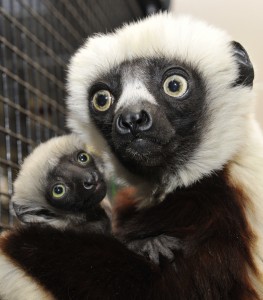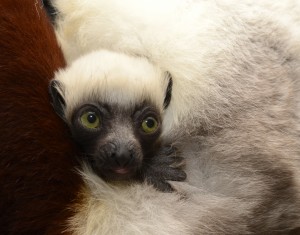February 18, 2014 – It’s birth season at the Duke Lemur Center! Two female Sifaka lemurs, Gertrude and Eleanor, were born on January 5, and more babies are expected in the coming months. In the dead of winter we are lucky to welcome new life to the center. Here’s what we do to get ready in the months before their arrival:
 First, rewind approximately 155-168 days to sifaka breeding season. Many of our sifaka family groups are part of the Lemur Center’s free-range program in which animals are allowed to roam in several fenced enclosures in Duke Forest. From mid- April to October, animals are out in the woods behaving like, well, lemurs! As the heat and humidity rise here in Durham so do the tender feelings of love between dominant sifaka females and their male counterparts. In lemur society females get first picks for food, the tastiest leaves, and the best nest spots. But for a few days in the summer the usually put-upon males suddenly find themselves in the favor of the females. Technicians and researchers monitor the behavior and health of the animals every day. Observing the animals during breeding season is essential to determining successful copulations and allows the staff to project birthdates. Observations can range from actual breeding events to something small like the female and male being “nice” — not typical in lemur society.
First, rewind approximately 155-168 days to sifaka breeding season. Many of our sifaka family groups are part of the Lemur Center’s free-range program in which animals are allowed to roam in several fenced enclosures in Duke Forest. From mid- April to October, animals are out in the woods behaving like, well, lemurs! As the heat and humidity rise here in Durham so do the tender feelings of love between dominant sifaka females and their male counterparts. In lemur society females get first picks for food, the tastiest leaves, and the best nest spots. But for a few days in the summer the usually put-upon males suddenly find themselves in the favor of the females. Technicians and researchers monitor the behavior and health of the animals every day. Observing the animals during breeding season is essential to determining successful copulations and allows the staff to project birthdates. Observations can range from actual breeding events to something small like the female and male being “nice” — not typical in lemur society.
A few months after breeding behavior is suspected the veterinary staff perform palpations and ultrasounds on the females. Everyone on staff makes sure to have their walkie-talkies turned up to hear the fateful call from the vets announcing impending arrivals or those females that might have better luck next season. Based on breeding behavior and the size of the fetus on ultrasound, we are able to project possible birthdates. When we feel we have the appropriate range in sight, we start marking the calendar in bold, highlighted letters for baby watch! As the birthdates approach technicians get busy preparing the animal’s indoor, winter housing for the baby. Pregnant mothers are offered cozy nest boxes lined in polar fleece or soft towels.
 The night before that first baby watch date is like Christmas Eve, especially for the primary caregivers. Nervousness, excitement, and great expectations are tempered a bit with the knowledge that these are fragile creatures and with any pregnancy, human or non-human, there are risks. When staff arrive at 6:30 AM, mothers are checked for new arrivals. Even for a trained eye it can sometimes be very difficult to find a 100-gram blob of fur tucked onto the mother’s lower abdomen. Once we’ve confirmed that there is indeed a new arrival and all appears well, mother and infant are given time away from other family members to allow the pair time to bond and to keep the infant from rambunctious siblings who just don’t understand that babies need some time to grow before it is time to play.
The night before that first baby watch date is like Christmas Eve, especially for the primary caregivers. Nervousness, excitement, and great expectations are tempered a bit with the knowledge that these are fragile creatures and with any pregnancy, human or non-human, there are risks. When staff arrive at 6:30 AM, mothers are checked for new arrivals. Even for a trained eye it can sometimes be very difficult to find a 100-gram blob of fur tucked onto the mother’s lower abdomen. Once we’ve confirmed that there is indeed a new arrival and all appears well, mother and infant are given time away from other family members to allow the pair time to bond and to keep the infant from rambunctious siblings who just don’t understand that babies need some time to grow before it is time to play.
Babies and Moms get a thorough examination by the vet staff to make sure both are doing well. Infants are gently removed from the mother and handled carefully by trained staff members. Once both are given the “thumbs-up” the infant is returned to mom’s warm belly and the pair is returned to their enclosure to rest and focus on baby growing!
In a few months he or she will be sailing through the forest just like lemur should!
a Sifaka haiku, by Bevan Clark
Tiny Sifaka
Hello, mid- winter surprise
Hold on tight Buddy!
 Bevan Clark has been at the Lemur Center since 2008. She is fond of all the prosimian species at the lemur center but finds herself drawn to small cantankerous lemur species, specifically the grey mouse lemur and the gentle grey bamboo lemur.
Bevan Clark has been at the Lemur Center since 2008. She is fond of all the prosimian species at the lemur center but finds herself drawn to small cantankerous lemur species, specifically the grey mouse lemur and the gentle grey bamboo lemur.

